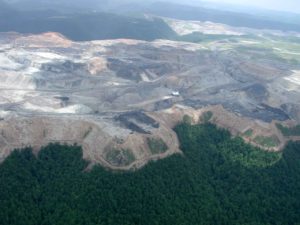Making Sense of the Rockwool Controversy
Plans by Rockwool (formerly Roxul USA, Inc.) to construct a 463,000 sq. ft. manufacturing facility in the City of Ranson have recently met with a firestorm of opposition. The facility, to be constructed on the old Jefferson Orchards property, will manufacture mineral wool insulation used in home and commercial construction. Opponents argue that the plant will emit huge amounts of toxic air pollution in close proximity to schools, and claim that the approval process was intentionally under-publicized to avoid opposition. Proponents argue that this is the single largest development project in Jefferson County since the Penn National Casino, and that it will create 150 well-paid manufacturing jobs, boost ancillary business and generate tax revenue for a substantial future period. To a large extent, this has become a contest of values.
I admit that I have come to this controversy late and that there is a lot I don’t yet understand. As an observer, I was initially impressed with the maturity with which both sides approached it. Recently, however, the rhetoric from the anti-Rockwool faction has gotten rough and somewhat personal. Yet it is apparent that we are not dealing with villains on either side. One can hardly blame Rockwool for trying to develop its business in the U.S. or the JCDA for recruiting Rockwool to the county. The Rockwool project is the kind of development the JCDA has been pursuing for decades. It is what Authority members have understood their jobs to be. Conversely, the opposition is not made up of eco-terrorists determined to wreck any development initiatives. There is sincere concern about the environmental impact of this facility, as well as what it means for further industrial development in Jefferson County.
The Product and Manufacturing Process
Mineral wool insulation has become increasingly attractive in the building process because of its efficiency as an insulator and its fire resistance. Rockwool products are produced from a combination of natural basalt rock and recycled slag from the steel industry. These are melted, spun into a fiber and cured into insulation. The company claims that buildings account for 40% of all energy use, and two-thirds of that is used for heating and cooling. It argues that insulation can play a key role in reducing heating and cooling costs, reducing greenhouse gas emissions, and providing a more comfortable work/living environment.
Rockwool’s November 2017 application to the WVDEP stated that the furnaces will be fueled by both coal and natural gas. Milled coal will be delivered by truck and the gas by pipeline. At that time there were no overt plans for a gas pipeline to Ranson. But lo and behold, on June 16, 2018 Mountaineer Gas announced a new route for its proposed pipeline so it could serve the Rockwool project.
All other raw materials will arrive at the site by truck and be stored in enclosures or piles. One factor not sufficiently addressed by either side, or the state of West Virginia, is the cost of wear and tear on our highways from the heavy truck traffic, which will divert funds earmarked for road repair elsewhere.
The furnaces will operate at extremely high temperatures – greater than 2,700 F. Various filtering and capture technologies will be used to reduce the emissions from the process. But excess heat from the furnaces, as well as particulate and greenhouse gasses that are not captured or filtered, will be emitted out of two 21-story smokestacks. Molten rock and slag will be extruded from the furnace, then spun and formed into the finished wool insulation, which will be shipped out of the facility by truck.
Rockwool recycles its own waste and when fully operational the facility will deliver no waste to the county landfill. The water and much of the heat generated in the manufacturing process will be captured and re-used.
Emissions and the Permitting Process
A critical step in the approval process for a new industrial site is an application to the West Virginia Department of Environmental Protection for a Prevention of Significant Deterioration (PSD) permit. A permit is required where a new facility is proposed for an area like Jefferson County that either has none of the regulated pollutants or is below the regulated maximum.
The application explains the manufacturing process and the places and manner in that process where emissions will occur. It then seeks to demonstrate that those emissions are below the limits set by federal and state regulations. This is an important point. Our federal and state governments have already decided what level of pollution is acceptable from “new sources.” If an applicant can show that its proposed facility will operate within those limits, then the regulations say the Secretary “shall” issue the permit unless there is some extraordinary reason not to do so. Many of us do not like where that leads, but that is reality.
The initial application for a permit was submitted by Rockwool on November 20, 2017. This application described the emissions expected from the facility’s operation. Public notice of the application was given in the November 22, 2017 Spirit of Jefferson. The notice, which was in the same size print as all other legal notices, listed the chemicals and particulate matter that have since become the major focus of opponents.
For example, Rockwool announced that its operations might annually emit 239 tons of nitrogen oxides, 148 tons of sulfur dioxide, 74.1 tons of carbon monoxide, 153,000 tons of carbon dioxide equivalents, 104 tons of methanol, 67.6 tons of formaldehyde, and so on. The public notice announced that written comments would be received by the WVDEP for 30 days and provided the telephone number for inquiries. This notice complied with the applicable regulation. In my opinion, opponents need to do better than to allege that Rockwool was somehow sneaky in notifying the public. If there is any bone to pick with the process, it is with the laxity of the public notice regulations, not Rockwool’s compliance with them.
The WVDEP is required to make available for public inspection all of the relevant documents and to put another notice in a newspaper of general circulation containing the same information from the first notice, but additionally that there has been a preliminary determination in favor of the permit, soliciting public comment and providing the procedures for requesting a public hearing. This was published in the Spirit of Jefferson in March 2018. No public hearing was requested by any interested party so WVDEP did not hold one. As a state we should do better than this. Public hearings should be required for major new source pollution, not optional.
Apparently the emission amounts proposed in the application were below the permitted level in each case because the final permit, issued on April 30, 2018, approved the emissions. Then on September 18, 2018 in response to the furor about the agency’s actions, the WVDEP issued the following statement:
There is no scientific evidence to suggest that the proposed facility will adversely affect human health or the environment. In addition to its plant in Mississippi, Rockwool has operated a similar facility in Canada for approximately 30 years. Based on the performance of the operations in Canada and Mississippi, and the WVDEP’s stringent air quality permit application review process, there is no reason to suspect that the facility in Jefferson County poses a threat to people living nearby or to the environment.
We are now left with the prospect of significant increases in toxic chemicals and particulate matter being emitted into the atmosphere at the Rockwool site, although most likely these will affect our neighbors to the east more than us. Notwithstanding Rockwool’s compliance with state emission limits, the Jefferson County environment will be considerably dirtier than before. The question is whether we value a clean environment more than the economic benefits that will accrue from the Rockwool project.
The Economic Bargain
The principal economic benefits Rockwool will bring to our community are manufacturing jobs and a substantial improvement in the property tax base that will fund schools. One thing our economy has lacked is solid manufacturing jobs for medium-skilled high school graduates. Rockwool says that when it is fully staffed, there will be 150 new jobs. A good portion of the 150 jobs, let’s say 120, will be in this category. Others will be management and clerical jobs. Opponents argue that while all jobs are important, Jefferson County has 57,000 residents. They say 150 jobs are not worth selling our environmental soul.
Although Rockwool hasn’t disclosed a wage scale, competitive manufacturing jobs pay in a range between $15 and $22 per hour, in addition to benefits somewhere in the range of 22% to 40% of the wage rate. So I’m figuring the annual payroll for Rockwool manufacturing jobs will be in the neighborhood of $6,500,000 ($20/hr. + 30% benefits x 2080 hrs. x 120 jobs). This money will be subject to state income tax and will circulate in the economy, boosting ancillary businesses such as grocery stores, gas stations, and the like. But it is not accurate to say that all this will be new money Rockwool brings to the county. Probably all of the people employed at Rockwool will come directly from other jobs, since unemployment is at an historic low. The new money will be the difference between what they were paid before and what they will earn at Rockwool.
In ten to twelve years, Rockwool will be paying millions of dollars of property tax to Jefferson County and the City of Ranson. Since these taxes will be based on the value of the taxed property at the time, it is hard to guess what they will be. We do know, however, that between 2020 when manufacturing operations will begin and 2030, Rockwool will pay vastly reduced taxes through what is called a PILOT Agreement. The Pilot Agreement has been approved by the Jefferson County Commission, the Jefferson County Board of Education, the City of Ranson, and several other officials.
The PILOT Agreement calls for real property tax payments of $225,000 in 2020 but no additional payments until 2026, when Rockwool will begin making escalating payments until an $815,000 payment in 2029. Presumably Rockwool will make full real property tax payments thereafter, which are not likely to be less than the 2029 amount. Rockwool expects to install perhaps $75,000,000 in new equipment at the facility, but this will be completely exempt from personal property tax until 2028. Then the PILOT Agreement will permit personal property tax on the machinery, but will artificially lower the value of the machinery on which the tax will apply to 5% of its depreciated book value. This sounds like a sweet deal for Rockwool.
Some Conclusions
Although our decisions can’t be driven by this, it is hard to imagine any county in West Virginia – except Jefferson – that would turn down the opportunity for a facility like Rockwool, even considering the environmental impact. Most would be doing back flips to get it. Perhaps it is our relative affluence that allows us to be choosier.
So I am tempted – almost – to be understanding about the Jefferson County Commission’s role in this. When one looks around for a governmental body that could have slowed the process until everything was fully vetted and discussed, that body was the County Commission — not the JCDA which, as noted, is supposed to go out and secure opportunities for us to evaluate. Instead, all the Commission really did was climb on the bandwagon. The Commission has since issued a memo saying that it had no control over anything except whether the county signed on to the PILOT Agreement, but this ignores political reality and how much influence and control the Commission could have exerted if it had been solidly against the project.
Now some Commissioners are running for cover. Commissioner Tabb was one of the county officials who visited the Rockwool plant in Mississippi and was impressed with what she saw. But as of August 2, Commissioner Tabb changed her mind because of the citizen opposition to the air quality issue. She now opposes Rockwool. At the same August 2 Commission meeting, Commissioner Hudson said that the Rockwool situation is “starting to smell like a skunk.” Commissioner Compton also claimed he is opposed to the Rockwool project, saying “The reason I agreed to this was I essentially thought it was going to bring jobs. Did I think it was to this extent of pollution and whatnot? Absolutely not.”
It is not clear to me that anything can be done to stop the Rockwool project at this point. Permits have been issued and binding contracts have been entered. Rockwool has spent lots of money in reliance on these. If the County Commission or one of the other governmental agencies that approved the deal backs out, there will be expensive litigation and an uncertain result. Indeed, Rockwool through its attorneys sent a letter on September 12, 2018 asserting that the company would suffer damages up to $100 million if the Commission delayed the project.
What is clear is that the citizens of Jefferson County have not been well-served by our County Commissioners. They did inadequate due diligence and had no clue about about public sentiment on the environmental issues. As but one example, here is a statement in the PILOT Agreement that Peter Onoszko signed as Chairman of the JCC:
The Commission has found that the [Rockwool transactions] will promote the public interests and public purposes by, among other things, providing certainty and soundness in fiscal planning and promoting the present and prospective prosperity, health, happiness, safety and general welfare of the people of Jefferson County.
Really? That’s not going to go down well with the thousands of people who have signed up on the anti-Rockwool Facebook page and who pack public hearings night after night. Instead of owning their failure, our Commissioners profess to have been either duped or powerless. There needs to be some accountability in November.

 Mountaintop removal involves clearcutting the extant forest, burning it and then pushing the debris into the adjacent stream valleys. Following this the top layer of rock is blasted away and this rubble too is pushed into the stream valley along with the topsoil. The coal being harvested is typically thin seam, which means that it is quickly exhausted and a new round of blasting is conducted until the next seam down is reached. Sometimes this process removes 800 feet of mountain.
Mountaintop removal involves clearcutting the extant forest, burning it and then pushing the debris into the adjacent stream valleys. Following this the top layer of rock is blasted away and this rubble too is pushed into the stream valley along with the topsoil. The coal being harvested is typically thin seam, which means that it is quickly exhausted and a new round of blasting is conducted until the next seam down is reached. Sometimes this process removes 800 feet of mountain. Environmental groups have resorted to lawsuits to force the FWS to do its job under the Endangered Species Act. In the last five years, these groups have sued to protect the northern
Environmental groups have resorted to lawsuits to force the FWS to do its job under the Endangered Species Act. In the last five years, these groups have sued to protect the northern